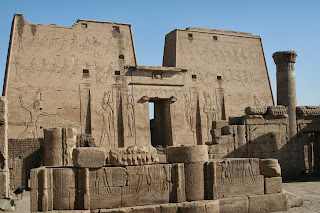What is a Lintel?
By Publications Manager Dan Rubin
Playwright Glen Berger writes, "Though we rarely recognize the place, underneath the lintel is where we stand every day, every moment, of our life." In this passage, the wordsmith is exploring the idea of the lintel in relationship to the word sublime, which means a sense of awe in the presence of vastness and can be broken down into sub ("under") and limen (which is derived from "lintel"). Accordingly, we are emotionally "underneath the lintel" whenever we are overcome with a sense of the sublime.
But in a more literal sense, we pass underneath lintels every day. Lintels are the top beams of most entryways, although they have become less structurally essential in modern architecture. Lintels are the limit of the threshold, which is defined not only as the space around a doorway, but also as a place or point of beginning. The lintel is the point from which we set out: on trips as mundane as our commute to work, on journeys as epic as an international adventure, on treasure hunts as winding as the Librarian's pursuit after a man who had the audacity to return his library book 113 years late, the lintel is our point of origin. It is our origin story, and has been since the dawn of architecture.
A fundamental element of Neolithic, Ancient Greek, and Ancient Egyptian architecture, the horizontal lintel is held up by two vertical posts or columns. Seen in its purest form in colonnades, the post-and-lintel system was the basis for all structural openings. Such ancient structures as Stonehenge (built between 3000 and 2000 BCE), in Britain, were constructed on the post-and-lintel system, as were the interiors of Egyptian temples and the exteriors of Greek temples.
Because of its prime location, the lintel became a frequent canvas for artists and visual storytellers. Below are examples of lintels that have survived hundreds of years to give us a glimpse of the past.
This limestone door lintel, with lion-griffins and a vase with lotus leaf, dates back to second and third-century Mesopotamia. Once part of a decorated doorway in the north hall of the so-called Main Palace at Hatra in northern Iraq (which was a major trade city heavily fortified against Roman attack and populated by a mixture of peoples), this lintel stone was originally positioned so that the carved surface faced the floor. The naturalistic modeling of the creatures' bodies and the form of the central vase reflect Roman influence, but the symmetry of the composition, the pronounced simplification of the plant forms, and the lion-griffin motif are all characteristic of the Near East.
This fragment of a Byzantine lintel from 400–550 CE with its deeply carved decoration resembles that on the door and window frames of early monumental churches in Syria. From The Metropolitan Museum of Art: "The symbol that divides the central roundel was understood as both a cross and a Christogram, the monogram for Christ's name formed from the first two letters of his name in Greek, chi (X) and rho (r). The alpha (A) and omega (Ω) that flank the cross, the first and last letters of the Greek alphabet, were widely used by Christians as symbols of the eternal nature of God. Their use was inspired by John the Evangelist's vision on the isle of Patmos (Revelation 1:8): 'I am the Alpha and the Omega, says the Lord God, who is and who was and who is to come, the Almighty.'"
The Mexican city of Yaxchilán was founded in the Early Classic period (250–600 CE) and became a major center of Mayan culture in the Late Classic period (600–900 CE). Its buildings were known for their elaborate decorations, particularly the sculptural door lintels that were commissioned by the city's rulers and are believed to document their history. This lintel from 681 CE was located above the central doorway of a palace structure. The image, carved in relief on limestone, depicts Lady K'ab'al Xook performing a bloodletting ritual that has manifested a vision of a serpent. From the mouth of the serpent, a warrior, carrying a shield and spear, emerges.
Click here to buy tickets and learn more about Underneath the Lintel.
Playwright Glen Berger writes, "Though we rarely recognize the place, underneath the lintel is where we stand every day, every moment, of our life." In this passage, the wordsmith is exploring the idea of the lintel in relationship to the word sublime, which means a sense of awe in the presence of vastness and can be broken down into sub ("under") and limen (which is derived from "lintel"). Accordingly, we are emotionally "underneath the lintel" whenever we are overcome with a sense of the sublime.
| The Temple of Horus at Edfu is an example of Egyptian architecture, including the post-and-lintel doorway seen at the center of the photo. |
| Stonehenge is an example of Neolithic post-and-lintel construction. |
Because of its prime location, the lintel became a frequent canvas for artists and visual storytellers. Below are examples of lintels that have survived hundreds of years to give us a glimpse of the past.
Click here to buy tickets and learn more about Underneath the Lintel.






